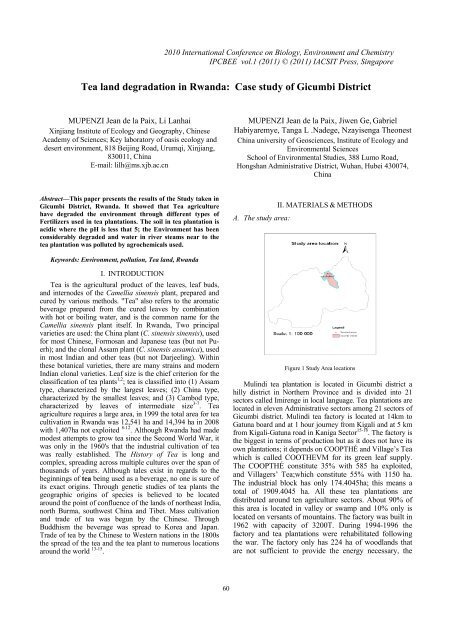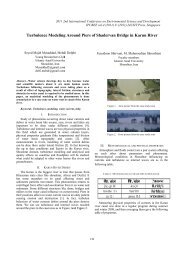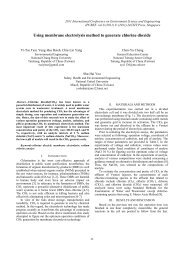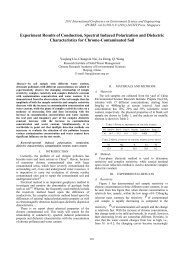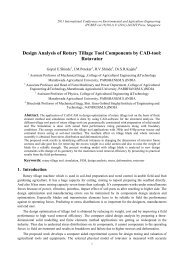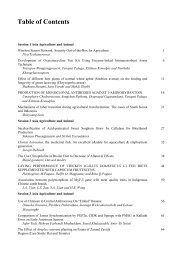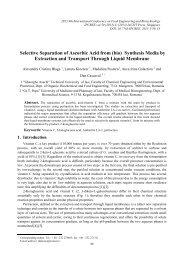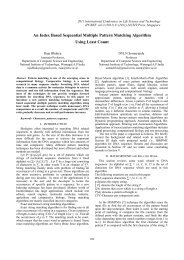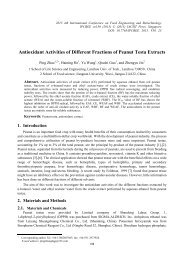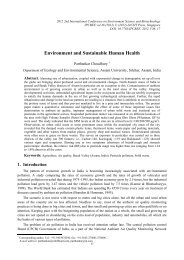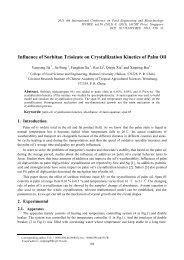Tea land degradation in Rwanda: Case study of Gicumbi ... - ipcbee
Tea land degradation in Rwanda: Case study of Gicumbi ... - ipcbee
Tea land degradation in Rwanda: Case study of Gicumbi ... - ipcbee
You also want an ePaper? Increase the reach of your titles
YUMPU automatically turns print PDFs into web optimized ePapers that Google loves.
2010 International Conference on Biology, Environment and Chemistry<br />
IPCBEE vol.1 (2011) © (2011) IACSIT Press, S<strong>in</strong>gapore<br />
<strong>Tea</strong> <strong>land</strong> <strong>degradation</strong> <strong>in</strong> <strong>Rwanda</strong>: <strong>Case</strong> <strong>study</strong> <strong>of</strong> <strong>Gicumbi</strong> District<br />
MUPENZI Jean de la Paix, Li Lanhai<br />
X<strong>in</strong>jiang Institute <strong>of</strong> Ecology and Geography, Ch<strong>in</strong>ese<br />
Academy <strong>of</strong> Sciences; Key laboratory <strong>of</strong> oasis ecology and<br />
desert environment, 818 Beij<strong>in</strong>g Road, Urumqi, X<strong>in</strong>jiang,<br />
830011, Ch<strong>in</strong>a<br />
E-mail: lilh@ms.xjb.ac.cn<br />
MUPENZI Jean de la Paix, Jiwen Ge, Gabriel<br />
Habiyaremye, Tanga L .Nadege, Nzayisenga Theonest<br />
Ch<strong>in</strong>a university <strong>of</strong> Geosciences, Institute <strong>of</strong> Ecology and<br />
Environmental Sciences<br />
School <strong>of</strong> Environmental Studies, 388 Lumo Road,<br />
Hongshan Adm<strong>in</strong>istrative District, Wuhan, Hubei 430074,<br />
Ch<strong>in</strong>a<br />
Abstract—This paper presents the results <strong>of</strong> the Study taken <strong>in</strong><br />
<strong>Gicumbi</strong> District, <strong>Rwanda</strong>. It showed that <strong>Tea</strong> agriculture<br />
have degraded the environment through different types <strong>of</strong><br />
Fertilizers used <strong>in</strong> tea plantations. The soil <strong>in</strong> tea plantation is<br />
acidic where the pH is less that 5; the Environment has been<br />
considerably degraded and water <strong>in</strong> river steams near to the<br />
tea plantation was polluted by agrochemicals used.<br />
II. MATERIALS & METHODS<br />
A. The <strong>study</strong> area:<br />
Keywords: Environment, pollution, <strong>Tea</strong> <strong>land</strong>, <strong>Rwanda</strong><br />
I. INTRODUCTION<br />
<strong>Tea</strong> is the agricultural product <strong>of</strong> the leaves, leaf buds,<br />
and <strong>in</strong>ternodes <strong>of</strong> the Camellia s<strong>in</strong>ensis plant, prepared and<br />
cured by various methods. "<strong>Tea</strong>" also refers to the aromatic<br />
beverage prepared from the cured leaves by comb<strong>in</strong>ation<br />
with hot or boil<strong>in</strong>g water, and is the common name for the<br />
Camellia s<strong>in</strong>ensis plant itself. In <strong>Rwanda</strong>, Two pr<strong>in</strong>cipal<br />
varieties are used: the Ch<strong>in</strong>a plant (C. s<strong>in</strong>ensis s<strong>in</strong>ensis), used<br />
for most Ch<strong>in</strong>ese, Formosan and Japanese teas (but not Puerh);<br />
and the clonal Assam plant (C. s<strong>in</strong>ensis assamica), used<br />
<strong>in</strong> most Indian and other teas (but not Darjeel<strong>in</strong>g). With<strong>in</strong><br />
these botanical varieties, there are many stra<strong>in</strong>s and modern<br />
Indian clonal varieties. Leaf size is the chief criterion for the<br />
classification <strong>of</strong> tea plants 1,2 ; tea is classified <strong>in</strong>to (1) Assam<br />
type, characterized by the largest leaves; (2) Ch<strong>in</strong>a type,<br />
characterized by the smallest leaves; and (3) Cambod type,<br />
characterized by leaves <strong>of</strong> <strong>in</strong>termediate size 3-7 . <strong>Tea</strong><br />
agriculture requires a large area, <strong>in</strong> 1999 the total area for tea<br />
cultivation <strong>in</strong> <strong>Rwanda</strong> was 12,541 ha and 14,394 ha <strong>in</strong> 2008<br />
with 1,407ha not exploited 8-12 . Although <strong>Rwanda</strong> had made<br />
modest attempts to grow tea s<strong>in</strong>ce the Second World War, it<br />
was only <strong>in</strong> the 1960's that the <strong>in</strong>dustrial cultivation <strong>of</strong> tea<br />
was really established. The History <strong>of</strong> <strong>Tea</strong> is long and<br />
complex, spread<strong>in</strong>g across multiple cultures over the span <strong>of</strong><br />
thousands <strong>of</strong> years. Although tales exist <strong>in</strong> regards to the<br />
beg<strong>in</strong>n<strong>in</strong>gs <strong>of</strong> tea be<strong>in</strong>g used as a beverage, no one is sure <strong>of</strong><br />
its exact orig<strong>in</strong>s. Through genetic studies <strong>of</strong> tea plants the<br />
geographic orig<strong>in</strong>s <strong>of</strong> species is believed to be located<br />
around the po<strong>in</strong>t <strong>of</strong> confluence <strong>of</strong> the <strong>land</strong>s <strong>of</strong> northeast India,<br />
north Burma, southwest Ch<strong>in</strong>a and Tibet. Mass cultivation<br />
and trade <strong>of</strong> tea was begun by the Ch<strong>in</strong>ese. Through<br />
Buddhism the beverage was spread to Korea and Japan.<br />
Trade <strong>of</strong> tea by the Ch<strong>in</strong>ese to Western nations <strong>in</strong> the 1800s<br />
the spread <strong>of</strong> the tea and the tea plant to numerous locations<br />
around the world 13-15 .<br />
Figure 1 Study Area locations<br />
Mul<strong>in</strong>di tea plantation is located <strong>in</strong> <strong>Gicumbi</strong> district a<br />
hilly district <strong>in</strong> Northern Prov<strong>in</strong>ce and is divided <strong>in</strong>to 21<br />
sectors called Imirenge <strong>in</strong> local language. <strong>Tea</strong> plantations are<br />
located <strong>in</strong> eleven Adm<strong>in</strong>istrative sectors among 21 sectors <strong>of</strong><br />
<strong>Gicumbi</strong> district. Mul<strong>in</strong>di tea factory is located at 14km to<br />
Gatuna board and at 1 hour journey from Kigali and at 5 km<br />
from Kigali-Gatuna road <strong>in</strong> Kaniga Sector 15-18 . The factory is<br />
the biggest <strong>in</strong> terms <strong>of</strong> production but as it does not have its<br />
own plantations; it depends on COOPTHÉ and Village’s <strong>Tea</strong><br />
which is called COOTHEVM for its green leaf supply.<br />
The COOPTHÉ constitute 35% with 585 ha exploited,<br />
and Villagers’ <strong>Tea</strong>;which constitute 55% with 1150 ha.<br />
The <strong>in</strong>dustrial block has only 174.4045ha; this means a<br />
total <strong>of</strong> 1909.4045 ha. All these tea plantations are<br />
distributed around ten agriculture sectors. About 90% <strong>of</strong><br />
this area is located <strong>in</strong> valley or swamp and 10% only is<br />
located on versants <strong>of</strong> mounta<strong>in</strong>s. The factory was built <strong>in</strong><br />
1962 with capacity <strong>of</strong> 3200T. Dur<strong>in</strong>g 1994-1996 the<br />
factory and tea plantations were rehabilitated follow<strong>in</strong>g<br />
the war. The factory only has 224 ha <strong>of</strong> wood<strong>land</strong>s that<br />
are not sufficient to provide the energy necessary, the<br />
60
eason why the factory is obliged to buy the firewood<br />
from the population around.<br />
B. METHODS<br />
At Mul<strong>in</strong>di tea plantation, we took soil samples by<br />
dryer on three locations which are Nyamul<strong>in</strong>di, Maya and<br />
Mukono for gett<strong>in</strong>g <strong>in</strong>formation relat<strong>in</strong>g to soil<br />
<strong>degradation</strong> through laboratory analysis us<strong>in</strong>g pHMeter.<br />
We also took water samples by tank <strong>in</strong> polyethylene and<br />
we put it <strong>in</strong> very cleaned bottles for a good transportation<br />
from three locations <strong>of</strong> Mul<strong>in</strong>di streams (Nyamul<strong>in</strong>di,<br />
Maya and Mukono). We analyzed both qualitatively and<br />
quantitatively water pollutants result<strong>in</strong>g from tea<br />
preparation activities <strong>in</strong> laboratory. These water samples<br />
were acidified with purified nitric acid and were analyzed<br />
through atomic mass spectroscopy. The measure <strong>of</strong> pH <strong>in</strong><br />
the solution used the follow<strong>in</strong>g elements:<br />
ammoniumacetae ammonia (pH 6-8), sodium acetateacetic<br />
acid (pH 3-6), and hydrochloric acid-glyc<strong>in</strong>e (p h 1-<br />
3). The water samples taken <strong>in</strong> three streams <strong>of</strong> Mul<strong>in</strong>di<br />
River us<strong>in</strong>g the tank <strong>in</strong> polyethylene beforehand r<strong>in</strong>sed<br />
with ultra pure water and it was taken 1L by location.<br />
RESULTS AND DISCUSSIONS<br />
<strong>in</strong> 2008 <strong>in</strong>clud<strong>in</strong>g the young tea and empty area <strong>in</strong>side <strong>of</strong> tea<br />
plantations but only 1909.4045ha give a production.<br />
A. Agrochemical<br />
The use <strong>of</strong> chemical fertilizers led to the decl<strong>in</strong>e <strong>of</strong> soil<br />
fertility 19 . To determ<strong>in</strong>e the impact <strong>of</strong> fertilizers <strong>in</strong> addition<br />
to laboratory experiment, <strong>in</strong> this <strong>study</strong>, we tried to use<br />
previous studies carried out <strong>in</strong> other <strong>study</strong> areas. For<br />
example, studies <strong>in</strong> India have shown that as much as 70% <strong>of</strong><br />
soil biota has been lost on tea plantations<br />
Quantity<br />
600000<br />
500000<br />
400000<br />
300000<br />
200000<br />
100000<br />
III. RESULTS AND DISCUSSIONS<br />
0<br />
1996 1997 1998 1999 2000 2001 2002 2003 2004 2005 2006 2007 2008<br />
Years<br />
TABLE 1 PRODUCTION, WOOD FUEL, FERTILIZERS, AREA IN MULINDI TEA<br />
PLANTATIONS FROM 1996 TO 2008<br />
Years<br />
Green<br />
leaves/kg<br />
wood<br />
fuel<br />
used/T<br />
fertilizers/kg<br />
Area/ha<br />
1996 3282152 3090 0 921.4<br />
1997 3241815 9115 0 921.4<br />
1998 4757300 11300 0 1026.9<br />
1999 8853154 6847 165662 1614.7<br />
2000 9238657 7732 153413 1642.2<br />
2001 13750123 14406 450000 1772.5<br />
2002 10072611 10629 370800 1762.5<br />
2003 9286082 10896 166850 1770<br />
2004 8731340 10581 470700 1909.4<br />
2005 11271253 12492 470800 1909.4<br />
2006 11148716 11945 235574 1909.4<br />
2007 13904538 15836 514616 2298<br />
2008 13678308 12774 370385 2298<br />
Total 121216049 137643 3368800<br />
Dur<strong>in</strong>g 13 years from 1996 to 2008, the production <strong>of</strong><br />
green leaves at Mul<strong>in</strong>di tea plantations <strong>in</strong>creased by<br />
10396156kg (316.74816%). Dur<strong>in</strong>g that period the us<strong>in</strong>g <strong>of</strong><br />
wood fuel had an <strong>in</strong>crease <strong>of</strong> 9684tones or 313.39806%<br />
while the use <strong>of</strong> fertilizers <strong>in</strong>creased from 0 kg <strong>in</strong> 1996 to<br />
370385kg <strong>in</strong> 2008. The total area was around 1900ha <strong>in</strong><br />
1996 but only 921.4ha were rehabilitated, and it was 2298ha<br />
Figure 2 Fertilizers (NPK) used at Mul<strong>in</strong>di <strong>Tea</strong> Plantations from 1996<br />
to 2008<br />
The Figure 2 shows that the use <strong>of</strong> fertilizers at Mul<strong>in</strong>di<br />
<strong>Tea</strong> Plantation was not regular; this can be expla<strong>in</strong>ed by the<br />
follow<strong>in</strong>g factors: Some farmers cannot afford the cost <strong>of</strong><br />
fertilizers while others lack knowledge about the importance<br />
<strong>of</strong> fertilizers to nearby natural habitat, especially <strong>in</strong> areas that<br />
workers and mach<strong>in</strong>ery pass over (Senapati et al. 2002). In<br />
general, <strong>Rwanda</strong> tea plantations and at Mul<strong>in</strong>di <strong>in</strong> particular,<br />
they use NPK 25-5-5 +1Mg and NPK 26-6-8 +2Mg very<br />
frequently as fertilizers. Other pesticides which are used <strong>in</strong><br />
different tea plantations are rounded up for elim<strong>in</strong>ation <strong>of</strong><br />
weed; urea, methane and dime thane for young tea or <strong>in</strong><br />
nurseries.<br />
B. Soil Degradation<br />
Soil Degradation at Mul<strong>in</strong>di was among the Ma<strong>in</strong><br />
objectives <strong>of</strong> this <strong>study</strong>; for its measurements, we used pH as<br />
<strong>in</strong>dicator. For that case pHMeter was used to analyze the soil<br />
acidity. It was found that the pH <strong>of</strong> soil samples collected on<br />
three locations <strong>of</strong> Mul<strong>in</strong>di valley was 5.2 at Nyamul<strong>in</strong>di, 4.8<br />
at Maya and 4.6 at Mukono. This means that the pH <strong>of</strong> soil<br />
<strong>in</strong> all Mul<strong>in</strong>di valleys is less than 7 and all soils are classified<br />
among the acidic soils. This acidity <strong>of</strong> soil can be expla<strong>in</strong>ed<br />
by the follow<strong>in</strong>g factors. First, the rock <strong>in</strong> which the soil<br />
came from, Mul<strong>in</strong>di valley belongs to the sedimentary rock.<br />
The second is the use <strong>of</strong> fertilizers with NO + 3 and f<strong>in</strong>ally an<br />
augmentation <strong>of</strong> alum<strong>in</strong>iums ions and H + <strong>in</strong> soil 20,21 .<br />
C. Analysis <strong>of</strong> Pollution<br />
61
TABLE 2 Concentration <strong>of</strong> H + , Cu, H 2NO 3, Al 3+ , NO 3, NO 2, Mg, Ca, Fe, K, P, and S <strong>in</strong> Mul<strong>in</strong>di streams (mg/L) <strong>in</strong> 2008<br />
Samples no Na H+ cu H 2 NO 3 Al 3+ NO 3 NO 2 Mg Ca Fe K P S<br />
1.Nyamul<strong>in</strong>di 31.85 26.4 13.2 13.1 2.06 1.14 20.3 12.2 46.1 0.18 3.8 0.26 20.2<br />
2.Maya 28.3 38.6 6.3 11.6 3.15 1.64 19.6 13.1 51.9 0.14 9.3 0.65 18.9<br />
3.Mukono 33.3 21.9 8.4 10.8 4.04 0.96 26.4 14.5 41 0.09 8.1 0.48 19.3<br />
The concentration <strong>of</strong> major elements <strong>in</strong> water at Mul<strong>in</strong>di<br />
valley varied by site. The result <strong>in</strong> table 2 showed that the<br />
concentration <strong>of</strong> Na, H + , H 2 NO 3 , Al 3+ , No 3 , NO 2 , Mg, Ca, Fe,<br />
K, P, and S were important <strong>in</strong> all sites with 31.85, 26.4, 13.2,<br />
13.1, 2.06, 1.14, 20.3, 12.17, 46.12, 0.18, 3.8, 0.26, 20.18<br />
respectively at Nyamul<strong>in</strong>di, with 28.3, 38.6, 6.3, 11.6, 3.15,<br />
1.64, 19.6, 13.05, 51.87, 0.14,9.3, 0.65, 18.9 respectively at<br />
Maya, and with 33.3, 21.9, 8.4, 10.8, 4.04, 0.96,26.4,<br />
14.46,41.04, 0.09, 8.1, 0.48, 19.3 respectively at Mukono.<br />
The <strong>study</strong> also showed that the concentration <strong>of</strong> Fe, NO 3 , K,<br />
Al 3+ were not important than other elements <strong>in</strong> all Mul<strong>in</strong>di<br />
valley, but the concentration <strong>of</strong> Ca, Na, H + , NO 2 , S, H 2 NO 3<br />
and Cu were highest <strong>in</strong> all valley. These concentrations<br />
<strong>in</strong>dicate that the water <strong>in</strong> Mul<strong>in</strong>di Valley are acidic and the<br />
pollution has its orig<strong>in</strong> from oxide <strong>of</strong> nitrate (NO 2 ) and the<br />
use <strong>of</strong> many fertilizers with high level <strong>of</strong> MPK + Mg . Note<br />
that this <strong>in</strong>strument (experimental) technique has been used<br />
by many researchers <strong>in</strong> environmental studies such as 22-27<br />
and several schemes are exist<strong>in</strong>g.<br />
IV. CONCLUSIONS<br />
The fertilizers used <strong>in</strong> the tea plantations were the cause<br />
<strong>of</strong> soil <strong>degradation</strong> and through those fertilizers the water<br />
was polluted. Also the deforestation resulted <strong>in</strong> soil erosion<br />
which led to floods and the deposit <strong>of</strong> sediments on the<br />
valley.<br />
ACKNOWLEDGEMENTS<br />
Our thanks go directly to the Government <strong>of</strong> <strong>Rwanda</strong>, to<br />
National University <strong>of</strong> <strong>Rwanda</strong> and X<strong>in</strong>jiang Institute <strong>of</strong><br />
Ecology and Geography for their f<strong>in</strong>ancial support, Pr<strong>of</strong><br />
Bukome Itangwa and Dr. Habumugisha Jean de Dieu (NUR)<br />
for their helpful comments and suggestions.<br />
REFERENCES<br />
[1] Claud Bald: Indian <strong>Tea</strong>. A Textbook on the Culture and Manufacture<br />
<strong>of</strong> <strong>Tea</strong>. Fifth Edition. Thoroughly Revised and Partly Rewritten by<br />
C.J. Harrison. Thacker, Sp<strong>in</strong>k & Co., Calcutta 1940 (first edition,<br />
1933).<br />
[2] Kit Chow, Ione Kramer (1990): All the <strong>Tea</strong> <strong>in</strong> Ch<strong>in</strong>a, Ch<strong>in</strong>a Books &<br />
Periodicals Inc. ISBN 0-8351-2194-1 References are to Czech<br />
translation by Michal Synek (1998): Všechny čaje Číny, DharmaGaia<br />
Praha. ISBN 80-85905-48-5<br />
[3] Samuel Kanyamibwa. Impact <strong>of</strong> war on conservation: <strong>Rwanda</strong><br />
environment and wildlife <strong>in</strong> agony. Biodiversity and Conservation<br />
1998:7(11): 1399-1406<br />
[4] Thomas streissgnth Juvenile Nonfiction. <strong>Rwanda</strong> <strong>in</strong> picture. 2007:<br />
70-8<br />
[5] MINISANTE/ONAPO Politique Nationale de la population pour le<br />
developpement durable au <strong>Rwanda</strong>. M<strong>in</strong>istry <strong>of</strong> health/National<br />
<strong>of</strong>fice for Family plann<strong>in</strong>g. InterScience, Kigali /<strong>Rwanda</strong> 2003 : 8-16<br />
[6] Nationsencyclopedia.com/Africa. <strong>Rwanda</strong> agriculture. 2009:2<br />
[7] <strong>Rwanda</strong> Privatization. <strong>Tea</strong> special <strong>in</strong> our magaz<strong>in</strong>e. <strong>Rwanda</strong><br />
privatization No11.Kigali 2009:6.<br />
[8] Lawrence w. Reed. A Privatization Revolution-<strong>in</strong> a Most Unlikely<br />
Place. General Article. Mack<strong>in</strong>ac Center 2002: 2-3<br />
[9] Siuberski, Philippe . Women run the show <strong>in</strong> a recover<strong>in</strong>g <strong>Rwanda</strong>.<br />
Wash<strong>in</strong>gtonpost.com Woman’s World 2008: 01<br />
[10] RICP . <strong>Rwanda</strong> climate, weather, Temperature, Ra<strong>in</strong>fall. World<br />
Travel Guide. Kigali 2008:1-2<br />
[11] WTO Doha Round Bullet<strong>in</strong>. Cont<strong>in</strong>ued reforms and technical<br />
assistance should help <strong>Rwanda</strong> <strong>in</strong> its efforts to achieve a dynamic<br />
economy: Trade policy Review: <strong>Rwanda</strong>. World trade organization<br />
2004: 2-3<br />
[12] Wikipedia,The free encyclopedia. Geography <strong>of</strong> <strong>Rwanda</strong>:<br />
Topographic map <strong>of</strong> <strong>Rwanda</strong>. Satellite image <strong>of</strong> <strong>Rwanda</strong>, generated<br />
from raster graphics data supplied by The Map Library. 2009: 2-3<br />
[13] Harler, C.R.: The Culture and Market<strong>in</strong>g <strong>of</strong> <strong>Tea</strong>. Second edition.<br />
Oxford University Press, New York and Bombay, Repr<strong>in</strong>ted 1958<br />
(First edition 1933, second edition 1956).<br />
[14] Hobhouse, Henry (2005). Seeds <strong>of</strong> Change: Six Plants that<br />
Transformed Mank<strong>in</strong>d. Shoemaker & Hoard. ISBN 1-59376-049-3.<br />
[15] Cook, Eleanor. A Reader's Guide to Wallace Stevens. 2007:<br />
Pr<strong>in</strong>ceton University Press.<br />
[16] Eelco Hesse (1982), <strong>Tea</strong>: The eyelids <strong>of</strong> Bodhidharma, Prism Press.<br />
ISBN 0-907061-05-0 [18] Francis. ICT Dream to the rural<br />
communities thanks to telecentres. Kigali. 2008: 1-2<br />
[17] OCIR-THE . A New tea sector strategy for <strong>Rwanda</strong> year 2005-2010.<br />
<strong>Tea</strong> strategy. Kigali 2006:2-12.<br />
[18] Wikipedia,The free encyclopedia. Geography <strong>of</strong> <strong>Rwanda</strong>:<br />
Topographic map <strong>of</strong> <strong>Rwanda</strong>. Satellite image <strong>of</strong> <strong>Rwanda</strong>, generated<br />
from raster graphics data supplied by The Map Library. 2009: 2-3<br />
[19] John C. Evans (1992): <strong>Tea</strong> <strong>in</strong> Ch<strong>in</strong>a: The History <strong>of</strong> Ch<strong>in</strong>a's National<br />
Dr<strong>in</strong>k, Greenwood Press. ISBN 0-313-28049-5<br />
[20] Senapati, S., Keiper, J. S., DeSimone, J. M., Wagnall, G. D.,<br />
Melnichenko, Y. B., Friel<strong>in</strong>ghaus, H. and Berkowitz, M. L. Structure<br />
<strong>of</strong> Phosphate Fluor surfactant Based Reverse Micelles <strong>in</strong><br />
Supercritical Carbon Dioxide. Langmuir 2002: 18(2): 7371.<br />
[21] Smichowski, P., G. Polla and D. Gomez et al;. Metal fractionation <strong>of</strong><br />
atmospheric aerosols via Sequential Chemical extraction: A review,<br />
Anal. Bioanal. Chem. 2005: 381:302-316<br />
[22] Smyth and Dumanski. Cited Ivan Good body, Elizabeth M. Thomas-<br />
Hope (1994) Natural Resource management for Susta<strong>in</strong>able<br />
Development <strong>in</strong> the Caribbean. Barbadon. Jamaica. Tr<strong>in</strong>idad 1993:<br />
323-372<br />
[23] M<strong>in</strong>istry <strong>of</strong> Lands, Resettlement and Environment. National<br />
environment policy <strong>in</strong> consultation with other state <strong>in</strong>stitutions,<br />
United Nations Agencies, NGOs and civil society. Kigali, 2003: 2-3.<br />
[24] Almeida, R.R et. Al. Veneer production from Eucalyptus grand is &<br />
Eucalyptus Urophylla hybrid clones wood. Forest Production Special,<br />
Dehradun / Indian 2004:5(2) 53-76.<br />
62
[25] Filgueiras, A.V, Filgueiras, I. Lavilla and C.Bendicho et al;.<br />
Chemical sequential extraction for metal partition<strong>in</strong>g <strong>in</strong><br />
environmental solid samples.DOI:10.1039/b20.1514c 2002: 720-823<br />
[26] Vijay Rawat, Negi, J.D.S. Biomass production <strong>of</strong> Eucalyptus<br />
tereticornis <strong>in</strong> different agro ecological regions <strong>of</strong> India. Cahiers<br />
Agricultures 2004: 130 (7): 6-12<br />
[27] ohn C. Evans (1992): <strong>Tea</strong> <strong>in</strong> Ch<strong>in</strong>a: The History <strong>of</strong> Ch<strong>in</strong>a's National<br />
Dr<strong>in</strong>k, Greenwood Press. ISBN 0- 313-28049-5<br />
63


